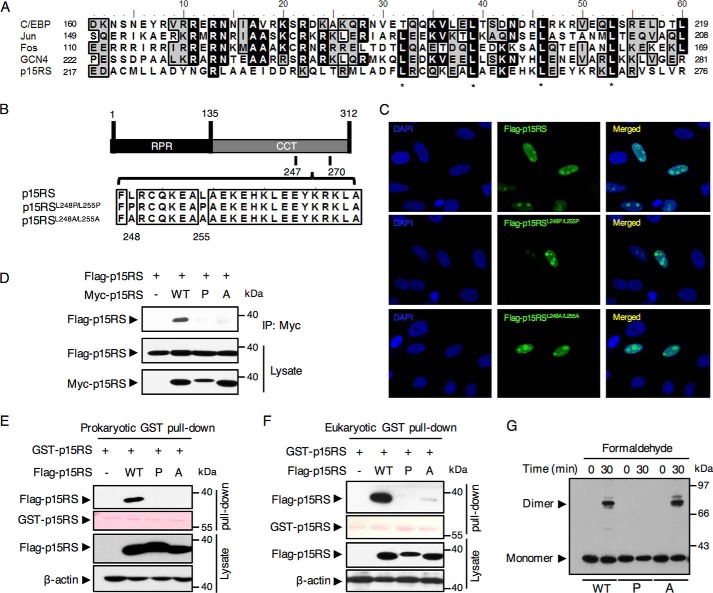Figure 2.
Dimerization of p15RS depends on the leucine zipper–like motif within its CCT domain. A, a similarity analysis of amino acid sequences of p15RS with typical leucine zipper–containing proteins by an alignment using Bioedit software. Identical amino acids were back-colored in black, whereas residues sharing similar characteristics were back-colored in gray. *, indicates critical leucines in the heptad structure. B, a schematic diagram of the mutation in the leucine zipper–like motif of p15RS. p15RSL248P/L255P (referred hereafter to as P): Leu-248 and Leu-255 double-substituted into prolines; p15RSL248A/L255A (referred hereafter to as A): Leu-248 and Leu-255 double-substituted into alanines. Full-length p15RS is referred hereafter as WT. C, mutations failed to affect p15RS localization in the nucleus. MCF-7 cells expressing Flag-p15RS, Flag-p15RSL248P/L255P, and Flag-p15RSL248A/L255A were fixed and stained with an anti-FLAG antibody followed by an anti-mouse IgG conjugated with FITC. Nuclei were counterstained with 4′,6-diamidino-2-phenylindole (DAPI). Cells were observed by a confocal microscope with a 400-fold magnification. D, p15RSL248P/L255P no longer dimerizes. Myc-tagged full-length p15RS, p15RSL248P/L255P, or p15RSL248A/L255A were co-expressed with FLAG-tagged p15RS in HEK293T cells. Cell lysates were incubated with an anti-Myc antibody and subjected to Western blotting by an anti-FLAG antibody. E and F, leucines 248/255 of p15RS are required for the dimeric interaction in vivo. GST pulldown assays were performed with purified prokaryotic (E) or eukaryotic (F) GST-p15RS proteins and FLAG-tagged p15RS, p15RSL248P/L255P, or Flag-p15RSL248A/L255A proteins expressed in HEK293T cells. Cell lysates were incubated with GST beads and subjected to Western blotting by an anti-FLAG antibody. G, p15RSL248P/L255P remains as monomer, whereas p15RSL248A/L255A forms dimer. HEK293T cells transfected with FLAG-tagged full-length p15RS, p15RSL248P/L255P, or Flag-p15RSL248A/L255A were subjected to cross-linking and detected by Western blotting using an anti-FLAG antibody.

